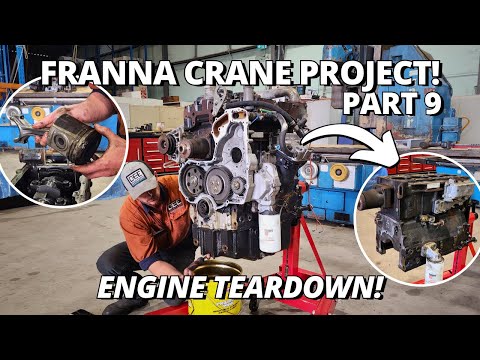Teardown & Inspecting The Engine! | Franna Crane Project | Part 9

how you going guys Kurtis from Cutting Edge engineering so today we're going to be continuing on with our Franna crane project and for today's job we are going to be disassembling the engine so this is a Perkins RS8 1603 engine it is a 4-cylinder and it is turbocharged so you do find these in a lot of different configurations they can be a constant speed engine used in a generator used on water pumps agricultural equipment trucks and pretty much anything else you need to power Perkins are a really good quality engine they are known for their reliability and their durability so it will be interesting to see what we find inside so I'm definitely not a diesel fitter by any means I used to rebuild my own engines for my drift cars I have worked on quite a lot of diesel engines in dozers excavators and scrapers but I have never pulled down a Perkins engine before so it will be interesting to see if there are any major differences between a Perkins to another style of engine so the main things I'm going to be looking looking for when I do disassemble it is any excess wear on say bearings or piston rings or on the pistons themselves so there wasn't any issues with the engine actually running it was the fuel problem that was giving us all the problems but this engine is only supposed to be a couple of hundred hours old the only way we're really going to figure that out is by opening up the engine and having a look inside so the first thing we're going to do I am going to remove the bell housing and the flywheel so we can get this onto the engine stand [birds squawking ] now that we got that mounted we can put it up on the stand righto guys now that we've got the engine mounted up on the engine stand first thing I need to do is drain all the oil out of it after I've drained the oil I'm going to start removing the accessories such as the alternator the turbocharger and anything else that just bolts on once we've done that we can start pulling the top off the engine now the oil's drained and out of the way I'm going to remove the alternator and now I'm going to remove the manifold and the turbo now I'm going to remove the valve cover then I'm going to remove the rockers and the push rods so just a couple of other little things to remove and then we can start unbolting the head that's really on there now we can unbolt and remove the head ooh so first impressions after removing the head we do have moisture in number four and number one that's quite unusual considering the engine has been completely sealed they look to be like little cornflakes that are growing in the piston I'm not really sure what's going on in there I did notice one small area of the gasket on number four was actually pushed out as if it had been over pressurized and the gasket had moved which may have resulted in water and coolant getting into number four but I didn't see any damage on the gasket around number one cylinder so I'm not sure why that's happenening in there but it does look like some sort of liquid has reacted with the top of the piston that doesn't look real good we're not going to know the extent of the damage until we remove the pistons out of the sleeves so we're going to continue to pull down the rest of the motor okay jeez louise oooh homeless sit spin around oh good boy [chomp chomp] that's it it's gone [snuffles] NO [being a big baby] goodboy [chomp] yesss [sniff sniff sniff] [nom nom nom] so I'm just going to get the rest of the coolant drained out of the block then I can remove the compressor and the timing cover should be able to just pull that off it's moving so it's just pushed in and then those three bolts that hold the idle gear on is what locks that from spinning and oil's fed through there now that all that's off I'm going to rotate the motor on the engine stand so I can remove the sump so with the sump off I did find that there is a lot of murky oil in there and by murky it's not the right color for a diesel engine to produce that color oil unless something has actually contaminated it and I also noticed around the oil pickup there is a lot of debris in the strainer and some of that debris is actually quite gritty it feels like sand there is also some surface rust or what looks to have been surface rust on the balance shafts so it is highly possible this motor might have had water in it at some stage so now what I'm going to do I'm going to remove the balance shafts and the oil pump that way I'll have clear access to remove the rod caps and pull out each piston oh put that to the side get out the next one why are they scratch going sideways they should be they should be scratched around them cuz that's the way that rotates why are they going across them extremely rusty nearly fell out that's what they're supposed to look like a bit of metal stuck to it that's a bit of metal it's foreign righto so we've got all four pistons out there is a little bit of unusual scratching on the sides of the piston and also on the big end bearings generally bearings you'll find the score or the scratches go around the bearing but these actually go across them that's a little bit unusual I'm not sure if that's a standard thing but I haven't seen that before we also notice there is a little bit of metal impregnated into number three piston just below the top ring we won't know if it's done any damage to the bore until we flip the motor back over but before I flip it over I going to pull out the crankshaft right guys so after removing all the main caps off the crankshaft all the of them are in pretty good shape except for number five it does have a scratch all the way around the crankshaft and also on the bearing I don't think it's going to be a massive issue it's probably something that could be linished out so now we're going to do a quick inspection of the crankshaft so the crank is a little bit tight to turn in the block that could just be material inside the bearings I can't see any more scratches it looks to be in pretty good shape so now we can get this out of the way and turn the motor over so we can inspect the bores [giggle] missed by that much so after having a quick look at the bores I don't need to look very hard to see that all four of them do have issues number one and number four have got rust marks that go around the diameter of the bore you can fill them with your fingernail that's the rust line [horrible scratching sound] I'm gonna say that's from water getting in there somehow and the motor sitting without being started for a pretty good period of time number two isn't in too bad of shape you can feel lines in that but number three has got lines from the top all the way to the bottom that bore was the one with the piston that had the metal impregnated into it and that corresponds with the scratches up and down the bore they're too deep to be honed out that's going to have to be oversized and also the bores are quite glazed there is no cross-hatching left in it and it is a silky smooth surface except for the scratches cylinder bores should have a rough surface in order to carry oil to lubricate the cylinder and the piston which means the motor has been idling for a long period of time so now that I've stripped down the engine and had a good look at it I do not believe this is a 400 hour old engine this has got a lot of wear on it and there is far too much damage that is done internally for it to be only 400 hours old it was probably an exchange engine they picked up from a wrecker or a secondhand part supplier but definitely not brand new so now that we know the condition of the engine it sort of does change things because we were working on a standard rebuild because now the bores are going to have to be machined oversized and we're going to need oversized pistons that is going to change the overall cost of rebuilding this motor not only that because we're not going to be cutting corners on this project I do need to take into account all of the other parts that I'm going to need to buy such as an injector pump a set of injectors and also getting the cylinder head serviced so now I need to sit down and work out whether it's cost effective to rebuild this or replace it with something else so that's as far as I can go on the engine for now but stay tuned for the next update cuz I got a lot more to do to that crane thanks for watching just not right guys oky doie then um how do I start it then so righto ugh [ __ ] [ __ ] right [ __ ] need other words so this is a 4-cylinder Turbo charged RS [giggle] now I can remove the rocker cover oh [ __ ] so now that I've stripped down the engine and is hmmmm [ __ ] try again and start again [air compressor] [ __ ] off train [ __ ] off train [phone ringing] moshi moshi [Karen] [gasp] jeez louise ugh not that strong [giggle] my god of course of course they're a different size course they're not [giggle] [Laughter] [Karen] one out of fifty finally got the right one [Laughter] [Karen] what the F is going on there I don't know [Karen] it's made muesli and it has started to grow some sort of white white [porridge hehe] white powder don't touch it so now I need to sit down and work out whether it's cost effective to rebuild this or replace it with something else [giggle] [Karen] no hints what Kurtis would prefer [Karen] that was the Crocodile [Homey destruction mode on] oh my God what are you doing [snort snuffles] hang on aye you little bugger [grunts] SIT come on let's go [disney princess arrives] [chirp chirp] [squawk] oh [chirp chirp] hoppity hop hop [giggle] their little hops are so cute [chattering] [more chatter] here Karen [giggle] what was that [chirp]
2023-11-24 17:05


